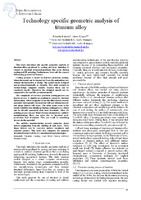Technology specific geometric analysis of titanium alloy

Megtekintés/
Metaadat
Teljes megjelenítés
Link a dokumentumra való hivatkozáshoz:
Gyűjtemény
- Bánki közlemények [136]
Absztrakt
"This study introduces the specific geometric analysis oftitaniumalloys produced bycasting and laser sintering. It extends to material structural problems that occurduring casting and 3D printing. Furthermore,it reveals the aspectsinfluencing geometrical features. Casting process is based on lost-wax precision casting, where the model can be burned out from the embedding wax without the formationof sludge. The model can be designed and produced manually or virtually. This study extends to virtual-designcomputer models, because these can be examined exactly. Therefore the designed model can be compared to the real-life, produced model. The complexity of lost-waxprecision casting process can lead to errors. A significant problem is caused by thermal deformation, which originates from the silica-based ceramic
material. Subsequently the material will not deform linearly and shape defects will occur. The other main cause is the metal’s solidification shrinkage during casting process, which can be directly measured after heat treatment. After 3D printing process (Laser Metal Fusion) of metalsi.e. additive manufacturing, flaws can arise due to incorrect post-production heat treatment. This can result in remaining stressesin the material. The additive manufacturing process generates shape defects originating from the melting of each layer. These shape defects
can be excessive surface roughness and rounded corners. This study also compares the material structural features of the two manufacturing technologies, it reveals the aspects influencing geometrical features. Casting process is based on lost-wax precision casting, where the model can be burned out from the embedding wax without the formation of sludge. The model can be designed and produced ma nually or virtually. This study extends to virtual-design computer models, because these can be examined exactly. Therefore the designed model can be compared to the real -life, produced model. The complexity of lost -wax precision casting process can lead to errors. A significant problem is caused by thermal deformation, which originates from the silica-based ceramic material. Subsequently the material will not deform linearly and shape defects will occur. The other main cause is the metal’s solidification shrinkage during casting process, which can be directly measured after heat treatment. After 3D printing process (Laser Metal Fusion) of metals i.e. additive manufacturing, flaws can arise due to incorrect post -production heat treatment. This can result in remaining stresses in the material. The additive manufacturing process generates shape defects originating from the melting of each layer . These shape defects
can be excessive surface roughness and rounded corners. This study also compares the material structural features of the two manufacturing technologies.
- Cím és alcím
- Technology specific geometric analysis of titanium alloy
- Szerző
- Kulcsár Klaudia
- Kónya János
- Megjelenés ideje
- 2018
- Hozzáférés szintje
- Open Access
- Nyelv
- ENG
- Terjedelem
- 73-78. p.
- Tárgyszó
- Titanium, Casting, Laser Metal Fusion, Additive Maufacturing
- Változat
- Kiadói változat
- Egyéb azonosítók
- MTMT: ISSN 2560-2810
- A cikket/könyvrészletet tartalmazó dokumentum címe
- Bánki Közlemények
- A forrás folyóirat éve
- 2018
- A forrás folyóirat évfolyama
- 1
- A forrás folyóirat száma
- 1
- Műfaj
- Tudományos cikk
- Egyetem
- Óbudai Egyetem
